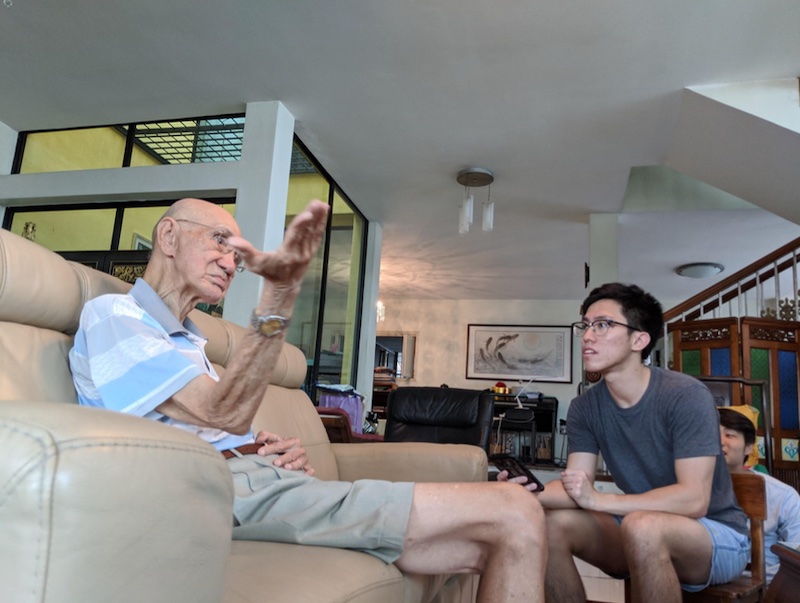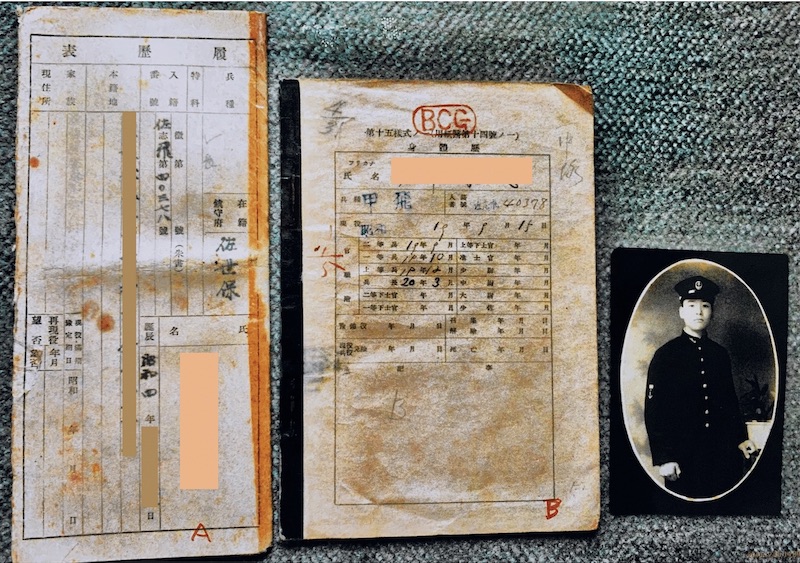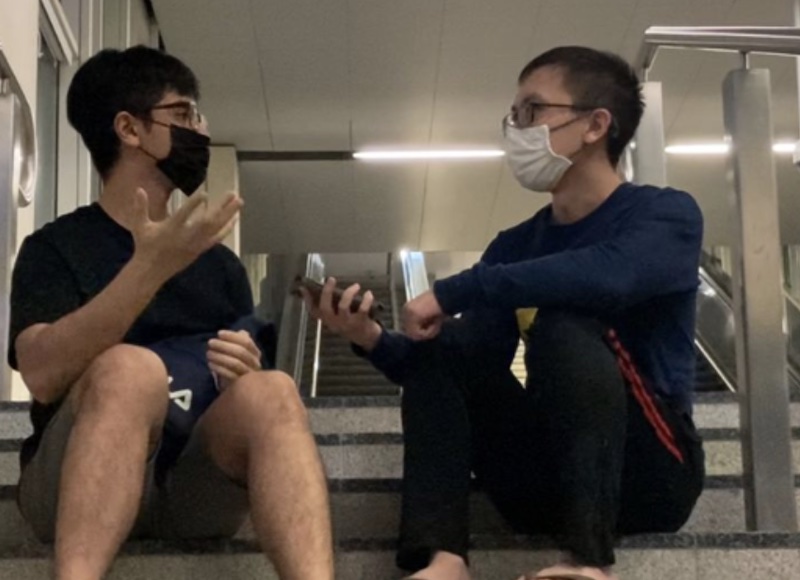Filters
| Search Suggestions |
|---|
| Begin typing to search |
Filters
| Search Suggestions |
|---|
| Begin typing to search |
Showing 0 results for: ___
| ID | ☆ | Type | Article | Author(s) | Countries Involved |
|---|
This section contains interviews conducted by SUTD students with eye-witnesses and survivors of World War 2 in Asia.

Personal Experiences of Singaporeans During the Japanese Occupation
Interviewees: Mr Liang, Huang Yin Di, Lim Boon Seng and many more...
Interviewer(s): Liang ChenYou, Fong Yuyang, Wesley Ler

Divergent Experiences of Singaporeans during the Japanese Occupation
Interviewees: Mr Loh, Mdm Yap, Mr Wen and many more...
Interviewer(s): Daphne Goh, Karthic Harish

Japanese Civilians under Japanese Military Rule: My Grandfather's Experiences and Reflections
Interviewees: Grandfather Sunao Toita
Interviewer(s): Yuuka Kuroishi

Perspectives on the Occupation
Interviewees: Mr Loo Kee Wei, Mr Kieran Pillai
Interviewer(s): Glenn Chia Jin Wee
| Student | Journal | Publication | URL |
|---|---|---|---|
| Huang Qiuhong | Emory Journal of Asian Studies | The Japanese Occupation of Singapore: Examining the Success of the Endau Settlement | link |
| Check back soon for more! | |||
This database consists of a collection of student bibliographies and primary source interviews, carefully curated to offer interesting online resources regarding Southeast Asia during the Japanese Occupation.
Watch pre-recorded, insightful talks by guest speakers!

Christopher Hale
Executive Producer,
Non-fiction Author,
Producer/
Director.

Clem Tillion
World War II Veteran,
Nine-term Alaska State
Legislator

Dr. Cao Yin
Associate Professor at Tsinghua University. Research interests: Modern India and India-China relations in the 20th century.
View recorded guest lectures here.
Read interesting interviews, newspapers and many more from the National Archives of Singapore and the National Library Board.
Even after eight decades, Singapore abounds with personal and institutional memories of the Japanese Occupation. The brief occupation of Southeast Asia (1941-45) during WWII was a complex phenomenon involving the complicity of many Asian nationalist leaders. While it did contribute to the unravelling of European colonial rule, it was at a tragic human cost, the ethics and gore of which are still debated both in academia and in popular media. Through scholarly texts, memoirs, fiction film (The Burmese Harp, Bridge on the River Kwai) and archival newsreels, this course will explore those tumultuous years in Burma, Indochina, Malaya, Indonesia, and the Philippines. We will read and discuss books and diaries, watch films, debate historical perspectives, take a field trip to the exhibition at the Former Ford Motor factory, and reflect on the lingering aspects of the Occupation.
| Week | Content Covered | Readings/Viewings (Subject to Modification) |
|---|---|---|
| 1 | Introduction. Syllabus, requirements and expectations from the course. |
(Viewing) Japan's War in Colour (2004). |
| 2 | Setting the stage: Before 1941. How were western and Asian populations responding to the Japanese presence in their socio-political spheres in Asia in the early twentieth century? What was the situation in Japan? What were the conditions in Europe and in Asia before 1941? Was a Japanese invasion expected? |
(Readings) Eri Hotta, Japan 1941 (excerpts) Louise Young, Japan's Total Empire: Manchuria and the Culture of Wartime Imperialism, Chapter 1, "Manchukuo and Japan." |
| 3 | Setting the stage: Before 1941 (con’t). How did ‘Pan-Asianism’ originate? How did the government and various civilian populations react to an impending Japanese presence? Why was the Burma Road such a strategic location? |
(Readings) Harper and Bayly, Forgotten Armies, (excerpts) Eri Hotta, Pan Asianism and Japan’s War, (excerpts) |
| 4 | Bicycles and Tapioca: The Japanese in Malaya. How did the Japanese army take over an entire peninsula by surprise? How did the local populations and the Allied forces react to the sudden incursion? What role did the Malayan communists play in supporting Britain’s war against the Japanese? |
(Readings) Harper and Bayly, (excerpts) (Viewing) Sergeant Hassan (1958). |
| 5 | The Fall of Malaya. The loss of Singapore has been described as the largest and most humiliating defeats ever faced by the British Empire. Was it simply because the great British guns were pointed the wrong way? What were the conditions that led to the defeat? |
(Viewings in class) Rising Sun over Malaya |
| 6 | ‘I cannot get over Singapore’. | (Readings) Brian Farrell, The Defence and Fall of Singapore, ‘The Worst Disaster?’ (excerpts) Christopher Hale, Massacre in Malaya, (excerpts) *Field trip to the Former Ford Motor Factory and the Kranji War Memorial. |
| 7 | Recess Week. | |
| 8 | Burma – A Railroad of Death. Why did Burma face a pivotal and long drawn out war? Why have so many movies and novels been produced on the mistreatment of Allied POW’s during the railroad construction? What were the roles of the local rulers and Japanese leaders in these events? How many Asian lives were expended? |
(Readings) Harper and Bayly, (excerpts) Richard Flanagan, Journey to the Deep Norths, (excerpts) (Viewing) The Bridge on the River Kwai (1957) or The Burmese Harp (1956). |
| 9 | The Dutch East Indies. Was Sukarno, the charismatic Indonesian leader misguided in collaborating with the Japanese after their take-over from Dutch rule? How did the Japanese try to persuade the Indonesian population to collaborate with them? What were the implications of the occupation as World War II grew and the Japanese ran out of resources? |
(Readings) Local opposition and underground resistance to the Japanese in Java 1942-45, Edited by Anton Lucas. (excerpts) (Viewings) Japanese propaganda newsreels. Source: Beeld en Geluid archives |
| 10 | The Dutch East Indies (con’t). | (Readings) The Defining Years of the Dutch East Indies, 1942-1949: Survivors’ Accounts, Edited by Jan A. Krancher (excerpts) William Bradley Horton, “Tales of a Wartime Vagabond: Hayashi Fumiko and the Travels of Japanese Writers in Early Wartime Southeast Asia” Under Fire: Women and World War Two (2014) (Viewing) Fires on the Plain (1959). |
| 11 | The Philippines. The highly anticipated rebuttal to Pearl Harbor and the American efforts at containing Japan in the eastern limits of Southeast Asia started the full combat in the region with heavy casualties. Why were the Philippines so important to both the Allied and the Japanese forces? How did it mark American involvement in Southeast Asia? |
(Readings) The Battle for Manila, (excerpts). |
| 12 | The INA and Subhas Chandra Bose. How did India’s Subhas Chandra Bose cobble together an extraordinary alliance of Indian POW’s, laborers, citizens and expatriates in creating an overseas army to overthrow British imperialism? Were his collaborations with Japan justified? What was the effect of such a nationalist effort among the Indian diaspora in Southeast Asia? |
(Readings) Joyce Lebra, The Indian National Army and Japan, 1971, (excerpts). Arunima Datta, Fleeting Agencies: A Social History of India Coolie Women in British Malaya (excerpts) (Viewings) The Forgotten Army: Singapore – The Beginning Assorted newsreels. Note: Please upload final paper outline (approx. 1 page) |
| 13 | Comfort Women. Among the most disturbing legacies of the Japanese Imperial Army is the installation of an efficient, militarized ‘comfort women’ system. How was this set in place? What are some of their personal narratives? Was this unique to Japanese rule? Has there been appropriate atonement and apology? |
(Readings) Hirofumi Hayashi, “Japanese Comfort Women in Southeast Asia” Japan Forum, Vol.10, No.2, 1998. “Disputes in Japan over the Japanese Military "Comfort Women" System and Its Perception in History” The Annals of the American Academy of Political and Social Science Vol. 617, The Politics of History in Comparative Perspective (May, 2008), pp. 123-132. (Viewings) Because We Were Beautiful (2010) Comfort Women Wanted. |
| 14 | Final Paper. |
Contact